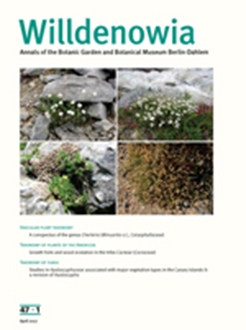Using the phylogeny of the tribe Cacteae as a model, we describe and trace the structural traits of its 135 taxa with the goal of reconstructing the growth form and wood evolution within the tribe. The reconstruction of growth form, podaria arrangement, wood, dilated rays, hypodermis cells, cortex and pith was performed using the parsimony method implemented in Mesquite. Although there is a high level of homoplasy, we speculate that many of the anatomical modifications are related to stem biomechanics, while others are adaptations to environmental changes that occurred during the diversification of the tribe during the Miocene period. The different combinations of morphological (podaria) and anatomical characters (dimorphic wood and lignification of the fundamental tissue) favour the maintenance of the growth form by avoiding stem deformation during long drought periods.
Version of record first published online on 14 March 2017 ahead of inclusion in April 2017 issue.





